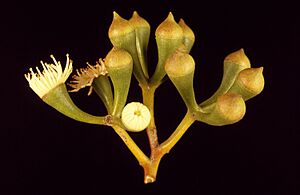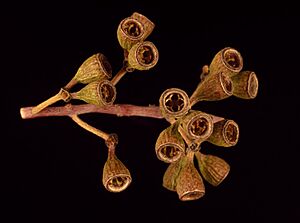York gum facts for kids
Quick facts for kids York gum |
|
|---|---|
 |
|
| Mallee form of Eucalyptus loxophleba near the Murchison River | |
| Scientific classification | |
| Genus: |
Eucalyptus
|
| Species: |
loxophleba
|
The Eucalyptus loxophleba, often called York gum, is a special tree or mallee that grows only in Western Australia. It's also known by its Noongar names: daarwet, goatta, twotta, or yandee. This tree has rough bark on its trunk and smooth, brownish bark higher up. It has long, narrow leaves, white flowers, and cone-shaped fruit.
Contents
What is York Gum?
The York gum is a type of eucalyptus tree or a mallee. A mallee is a plant that grows many stems from a special underground root called a lignotuber. York gums usually grow between 5 and 15 meters (about 16 to 49 feet) tall.
How to Spot a York Gum
- Bark: The bark on the main trunk is rough and flaky. Higher up, the bark is smooth and can be grey-brown or copper-colored.
- Leaves: Young plants have triangular or egg-shaped leaves. Adult leaves are long and curved, a shiny dark green on both sides. They are about 7 to 15.5 centimeters (about 3 to 6 inches) long.
- Flowers: The flower buds grow in groups of seven, nine, or eleven. They are oval or pear-shaped. When they open, the flowers are white. York gums can flower in most months of the year.
- Fruit: After flowering, the tree produces woody, cone-shaped fruits. These fruits are about 4 to 8 millimeters (about 0.16 to 0.31 inches) long.
Naming the York Gum
The scientific name, Eucalyptus loxophleba, was first given to this tree in 1867 by a botanist named George Bentham.
What Does Loxophleba Mean?
The name loxophleba comes from two Greek words:
- loxos, which means "cross-wise"
- phleps phlebos, which means "a vein"
This name likely refers to the pattern of veins in the leaves.
Different Types of York Gum
Scientists have found four different types, or subspecies, of York gum. They are:
- Eucalyptus loxophleba subsp. gratiae: This is a tree with smooth, shiny bark. It has larger leaves, buds, and fruit.
- Eucalyptus loxophleba subsp. lissophloia: This type is a mallee, meaning it has many stems, and its bark is mostly smooth.
- Eucalyptus loxophleba subsp. loxophleba: This is the original type of tree. It has rough bark all the way from the trunk to its smaller branches.
- Eucalyptus loxophleba subsp. supralaevis: This tree has rough bark only at the bottom of its trunk. The bark on its larger branches and upper trunk is smooth.
Where York Gum Grows
The York gum grows across a large part of Western Australia. You can find it from the Mid West region, through the Wheatbelt, and east into the Goldfields-Esperance area.
Preferred Living Conditions
This tree likes to grow in many different places, such as:
- Rocky areas
- Flat lands
- Hills and slopes
- Near salt lakes
- Along natural water paths
It can grow in various soil types, including red-brown loam, sandy soils, or sandy clays. The name "York gum" comes from the town of York, where the tree was very common in early settlement times.
Conservation Status
Good news! The Western Australian Government's Department of Parks and Wildlife says that the York gum is "not threatened." This means it's not currently in danger of disappearing.
Uses of York Gum
York gum trees are useful for a few reasons:
- Helping Salty Land: These trees naturally grow in areas where the soil has become salty due to dry conditions. All four types of York gum could help fix this problem. The subspecies lissophloia is especially good for this.
- Oil Production: The lissophloia subspecies is also grown to produce oil. It's sometimes called an "oil mallee."
- Carbon Capture: This subspecies has been planted in other parts of Australia to help capture carbon dioxide from the air. This helps fight climate change.
- Wood: Historically, the wood from the loxophleba subspecies was used by people who made wheels and other wooden items. The wood is strong, tough, and has a yellow-brown color.
Images for kids
-
Cultivated specimen in Jardín Botánico de Barcelona






